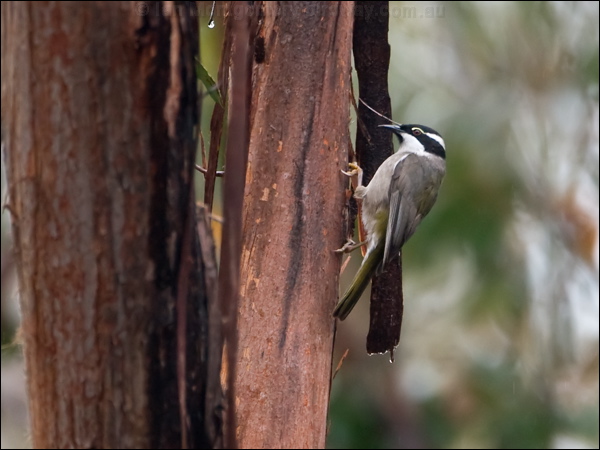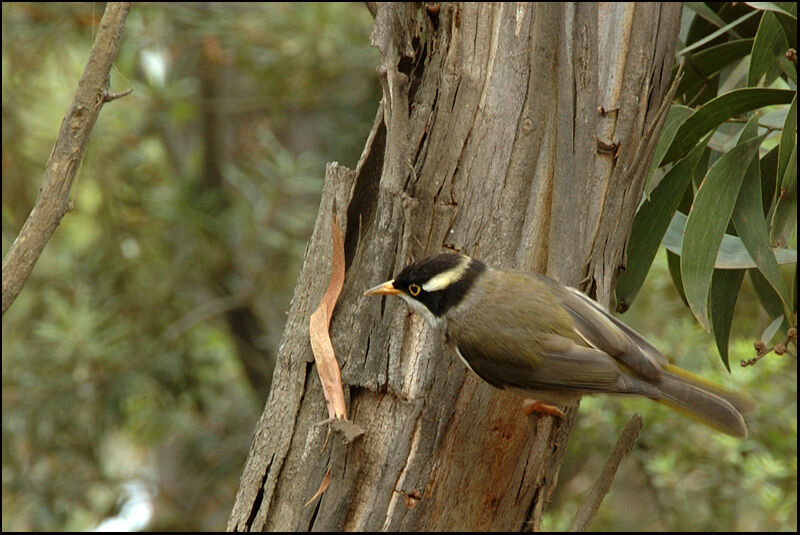Strong-Billed Honeyeater Biography








The Strong-billed Honeyeater is the larger of the two Tasmanian Melithreptus honeyeaters. It has a large, almost straight black bill with a heavy base and sharply pointed tip, as well as a strongly built neck and shoulders. The head is black, with a distinctive white crescent across the back of the neck, white-green eye-skin and a white chin and throat. The upperparts are olive-grey to green above with the underparts a dull grey-green. Young birds resemble adults, but have a lemon-yellow tinge to the back of the neck, a browner head and a yellow-orange bill and eye-skin. In behaviour, this species resembles treecreepers, moving up and down the trunks of trees in search of insects. It is often seen with other honeyeaters, especially the related Black-headed Honeyeater, as well as pardalotes and thornbills, and is very noisy and gregarious when feeding.
The only other Melithreptus honeyeater in Tasmania
The Strong-billed Honeyeater is endemic to Tasmania and the Bass Strait Islands King Island , and is widespread on Flinders Island Cape Barren Island , as well as other offshore islands such as Hunter, Maria and Bruny Islands
The Strong-billed Honeyeater is found in old or mature wet forests with stands of Mountain Ash or Alpine Ash and a shrub understorey, especially in gullies, but it will move into drier forests on slopes during winter. It will also be found in cool temperate rainforests dominated by Antarctic Beech, as well as dry forests with mature trees and in coastal or wet scrubs near wetlands. May sometimes be seen in parks and gardens and in orchards.
The Strong-billed Honeyeater, unlike other Melithreptus honeyeaters, feeds mostly on insects. It will also eat nectar and fallen fruits on occasion. It has a short, strong bill and heavy shoulders, adapted for ripping the bark of trees. Foraging like a treecreeper, it moves at all levels, from the canopy to the ground, by hopping up and down the vertical trunks and ripping noisily at the bark. It will also feed in foliage and on flowers, as well as on the ground. Often seen in flocks of two to four during the breeding season, it will group together in much larger flocks at other times and often forms mixed flocks with the Black-headed Honeyeater.
The Strong-billed Honeyeater forms monogamous breeding pairs, which may receive help with raising young from other adults and members of previous broods. Nesting often occurs in small colonies in 'traditional' areas, with colony members returning to the same general location each year. All adults help with nest-building, forming a small, deep cup-shaped nest from bark strips covered with lichen and lined with soft bark, the fuzz from tree-ferns, Dicksonia species, and other plant or animal fibres. The nest is suspended by the rim from the outer foliage of eucalypts and shrubs or in the crown of a tree-fern. Both parents incubate and feed the young, with other adults sometimes helping with feeding and defence of the nest.
Strong-Billed Honeyeater

Strong-Billed Honeyeater

Strong-Billed Honeyeater

Strong-Billed Honeyeater

Strong-Billed Honeyeater

Strong-Billed Honeyeater

Strong-Billed Honeyeater

Strong-Billed Honeyeater

Strong-Billed Honeyeater
Strong-Billed Honeyeater
Honey Eater And Padelemon
No comments:
Post a Comment